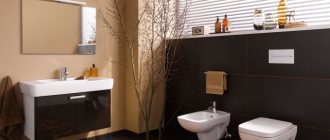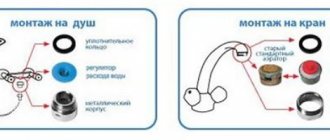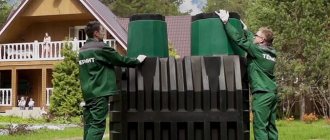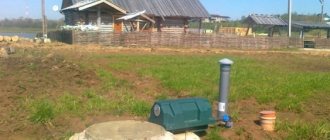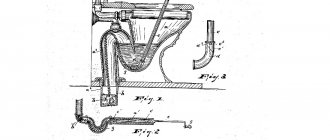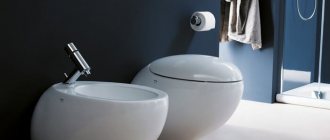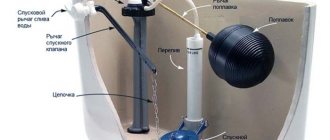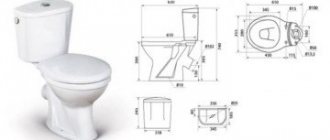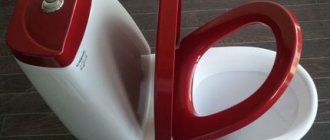On the relevance of norms and standards
Mostly redevelopment consists of physical or visual expansion of the premises. Less often – in reducing and saving space. Problems for owners who decide to undergo a major renovation arise if the plumbing in the apartment is already installed. Dismantling it and moving it to another place is a serious procedure, which requires special permission. The renovation project must be agreed upon and legalized and subsequently included in the technical passport of the apartment. It is impossible to start work without permission, since unknowingly you can damage the load-bearing wall, which will lead to the destruction of the entire house. In order to avoid this when installing plumbing fixtures, there are established norms and standards, in which such parameters as the height of the toilet, the size of the restrooms, the height of the ceilings and others are already prescribed at the legislative level.
Advantages and disadvantages of seat pads
This is a budget alternative to a separate toilet, and therefore attracts the attention of a larger audience of parents. The pads are presented in a sufficient assortment in stationary stores, so there will certainly not be any difficulties with purchasing and choosing them. Every parent can install such a device on the toilet; this does not require any special skills or special tools. Another thing is that such a device cannot provide the necessary level of safety for the child; parents will have to constantly monitor his visit to the toilet in order to prevent an accident.
Standards
The previously valid document “Sanitary equipment of buildings and structures” (SNiP PI–28-75) became invalid after the introduction of a new one – “Internal sanitary systems” (SNiP 3.05.01–85). The new document applies to work with hot and cold water supply, sewerage, heating, ventilation, drains in industrial and residential buildings. The information residents need to replace indoor plumbing fixtures is contained in this document.
Primary requirements
The standards for the distribution of plumbing fixtures set out in the document provide for:
- the distance from the toilet to the bidet should be 0.25 m;
- It is necessary to have free space in front of the bathtub or shower - 0.70 m;
- the free space in front of the toilet should be 0.60 m;
- on the sides of the toilet it is necessary to provide for free space - 0.25 m;
- the space near the washbasin should be 1.1 m long and 0.7 m wide;
- the shower mixer should be located at a height of 1.2 m;
- The height of the toilet should be 0.6 m.
About the diversity of standards
Currently, there are numerous factories, factories and companies specializing in the manufacture of plumbing equipment. Domestic and foreign manufacturers produce their products, focusing on the standards in force in their country. Plumbing standards become internal and lose their relevance. But, nevertheless, they continue to be standards, and they should be followed if the apartment owner does not want unnecessary problems during planning or major repairs.
Criterias of choice
If the decision is made in favor of purchasing a children's toilet, then you need to approach this idea carefully and very seriously.
To avoid mistakes, you should rely on some criteria.
- The comfort of using a children's toilet is put in first place. It is necessary to focus on the dimensions of the child or several children if there is more than one baby in the family;
- Very important is the attractive design of the children's toilet, which is expressed in a unique shape and color. The child should like the appearance of this device, since this guarantees a desire to use it. If the baby likes everything, then he will be more willing to clean his personal plumbing fixtures;
- You need to be smart about choosing the size of a children's toilet. You should take into account the child’s growth, and purchase a device with a view to using it for several years;
- It is recommended to support the child’s attention to the plumbing fixture with the help of its design. You need to find out from your child what he likes, for example, which cartoon character. This will give the equipment significance;
- It is worth paying attention to the materials used to make the device. They must belong to the environmentally friendly category. It is important that contact with a child’s toilet does not cause various allergic rashes;
- Comfort does not mean that a child’s toilet should be functionally different from an adult’s. Any child will be pleased if everything is done identical to what he sees with his dad or mom.
How to choose a toilet?
A well-appointed bathroom is an integral part of modern housing. One of the main and essential elements of any toilet is the toilet. Now on the plumbing market there are many different models that have their own design features. Different companies use their own technologies in the production process, products are made from different materials. Products made from sanitary faience are in great demand today. When choosing a toilet, you should take into account the needs of the family, the number of people, and the size of the room in which installation is planned. The choice is also made taking into account the individual characteristics of the consumer. For large people, it is advisable to choose a tall toilet equipped with a wide bowl. For slim people, a narrow model would be an ideal option. According to the recommendations of experienced plumbers, when choosing a toilet, it is best to focus on the tallest member of the family.
How to choose a suitable design
Frog-themed design
You can and should involve your child in purchasing children's plumbing equipment. It is advisable that he likes the color and design. Otherwise, you should take into account the age, weight of the child and ease of use.
Many users who have already installed a children’s water closet at home recommend buying a model “for growth.” Children grow quickly, so it is better to immediately choose plumbing fixtures that are a little larger than what is needed right now.
As for materials, traditionally toilets for children are made of earthenware or porcelain. It is better to refuse plastic, as this is not the best option from a hygiene point of view. Earthenware is more fragile, but it is cheaper than its porcelain counterpart.
The type of pad is selected taking into account the age of the child. It will be more convenient for the little ones to use the seat and ladder. For older children, it is possible to choose a regular or anatomical pad.
Types of structures
Depending on the method of installation of compact toilets, their types differ:
- Hanging. They are equipped with separate tanks, which are installed in the wall or behind the partition. Products with this design are not mass-produced.
- Floor compacts are considered the most common.
According to the shape of the structure there are:
- oblique;
- horizontal;
- vertical.
When creating compact toilets, first of all, the physiological parameters of a person are taken into account, and then the designer’s imagination.
Products with a microlift, a mechanism that ensures smooth lowering of the seat, have become very popular. Such products are quite expensive.
Types and design features
The dimensions of toilets depend on the design. So it is necessary to familiarize yourself with them. At the same time, we’ll find out which types can be installed in small bathrooms.
You don’t always immediately understand what and where
Bowl shape
The types of toilets based on the flush or bowl shape determine the ease of use and the level of “odors” that may be present. The minimum and maximum dimensions also depend on the shape. There are three types of bowls or drain:
Standard toilet sizes depend on the type of bowls
- Dish-shaped or with a shelf. The drain is moved closer to the front wall, and the bowl has a protrusion, which some call a shelf, and others a plate. Hence the names of the forms. With this device, there will be splashes when draining, which is unpleasant, but at least you won’t feel them. However, a toilet with a shelf is the most “fragrant”. The excrement remains “on the shelf” until it is washed off, so the smell is intense.
- Kozyrkovy. The drain is also closer to the front wall, but the back wall of the bowl is flat, with a slight slope towards the drain funnel. With this design, waste falls on the back wall and slides along it into the water. There is no splash, the smell is present, but not so intense. Traces remain, even though the main source is in the water.
- Funnel-shaped. The shape of the bowl of this toilet is similar to a regular funnel. The drain is almost in the middle. There will be almost no smell, but you will feel the splash. Literally. You can fight splashes either by moving forward/backward, as the dimensions (of yours and the toilet) allow, or by first throwing a piece of toilet paper into the water.
Which toilet is better to choose? In general, it’s not a bad visor. No splashes, with a tolerable level of “aroma”. However, after each use you will have to use a brush. But you quickly get used to this procedure.
Installation method
Depending on the installation method, there are two types of toilets: floor-mounted and wall-hung. With floor-mounted ones everything is clear; they are installed on the floor and secured to it. They come in two types. The first one is familiar to us with a tank on a remote shelf or with a tank on the wall. The second type is wall-mounted. We recently got this option. It differs in that the back wall is almost completely parallel to the wall.
Most toilets are installed on the floor. There are regular models and wall-mounted ones. There are also hanging ones. They require a special frame, which is hidden behind a false wall. This frame is called an installation
A wall-hung or built-in toilet is not attached to the wall, as it might seem, but to a structure that is hidden behind a false wall. This design is called "installation". This is a metal frame that is bolted to the walls and floor. And not only the bowl, but also the button and all the pipes are attached to this frame.
Release
This is not all the design features. We still need to sort out the release. This is the outlet pipe through which the toilet is connected to the sewer. The most compact models with a vertical pipe outlet. The longest ones are oblique. But they are the ones that are more common, since there is no need to lift the sewer pipe, but you can only install a tee and insert a corrugation into it.
There are also three forms of toilet outlets: straight, oblique and vertical. Vertical ones are now very rare, although you can find them if you want. This standard is used in America. But anything can be made to order. By the way, it is the toilets with vertical outlet that will have the smallest “depth”. And with such an output they usually make wall-mounted models.
The outlet of a toilet is its outlet pipe. They come in three types: straight (horizontal), oblique and vertical.
How to choose a toilet by release? If you are just replacing the toilet and don’t plan to redo the sewer system, there is really no choice. You need it with the same release that was. No options. When replacing sewer pipes in an apartment, it will be possible to change the oblique to a straight one, or vice versa - a straight to an oblique one. But it won’t be possible to install a vertical one - the drain must go vertically downwards, that is, to your neighbors below. This means that they will have to make a replacement too. When should you choose a vertical drain? In a private house, it is better on the ground floor. In the underground or basement, the pipe will not bother anyone. And the advantage of this type has already been announced - this is the minimum “depth”.
Types of toilet cisterns
Before you deal with standard toilet sizes, you also need to think about the type of tank. This also affects the size. For example, the popular compact model is far from the “shortest”. Here the palm goes to models with a separate wall-mounted tank. But we must also take into account the pipe with which the tank and toilet are connected.
Toilet tanks also affect the size. Often they are either an integral part or cast in a single mold
In general, there are three types of toilet cisterns: separate (wall-mounted), compact and monoblock. Compact and monoblock can be straight or angular. Corner models are usually the smallest. And they definitely allow you to save space in a small toilet.
What are the differences between the tanks? There is no fundamental difference. It's a matter of the owners' preferences, and, well, appearance. A monoblock is when the bowl and tank are cast in a single form and cannot be separated. Compact is when the tank is installed on the back of the bowl. In such models, the bowl has a special outlet behind it with holes for attaching the tank. What's good about this option? You can change tanks. Not only if the old one cracked, but also if you missed the shape or volume. This also happens. Wall-mounted tanks have the same advantages. The only difference is that you will have to fasten them and install a connecting pipe.
The least amount of installation space is required for the dryer. This is a tankless drain system
By the way, there are toilets without tanks. These are not those in which they are hidden in the installation, but those that are directly connected to the water supply. This model is used in Germany, and we also have it in some public toilets. Its main advantage is saving space. Whatever one may say, the tank takes up space. If space is really tight, you can install one like this. True, provided that there is enough pressure in your system for it to work.
Budget model
Among the cheap compacts, economy class products should be highlighted. These are toilets from the Russian manufacturer Sanita Luxe.
Those wishing to purchase a high-quality, but at the same time inexpensive toilet bowl can opt for the Russian compact model. It costs up to 2000 rubles. Sanita Luxe uses porcelain in the production of toilet bowls. The products are equipped with a lid and a lower water supply to the drain tank. These toilets have an affordable price, they are characterized by a high-quality fastening method, a wide variety of bowls, an effective flush system and an additional anti-splash feature. The formation of the cost of the model is significantly influenced by the type of toilet, the material used for its manufacture, the design features inherent in the product and additional functional elements. Based on their price, Sanita Luxe toilets can be expensive, mid-priced or cheap.
Options
Toilets from the manufacturer Sanita Luxe come in two versions:
- Floor-standing. This is a classic option. It is installed on a special leg, which smoothly transitions into the bowl.
- Hanging. These products are primarily intended for toilets with limited space. Such products are more aesthetically pleasing and elegant than floor ones. This is due to the fact that wall-mounted toilets do not have any visible communications. The floor does not deform during their installation. As a result, space is visually freed up. Convenience when cleaning the premises is also considered an advantage.
Options
Indicators of hanging products:
- the height of the toilet from the floor should be 35–40 cm;
- width 35–37 cm;
- length or depth 48–70 cm.
Wall-hung toilets are characterized by significant strength. They are able to withstand a weight of 400 kg.
The toilets from this manufacturer contain such an additional element as an attached skirt. It covers the bottom base of the toilet and prevents it from getting dirty. This toilet model is ideal for a room whose area exceeds 6 square meters. meters.
Despite all their advantages, wall-hung toilets are less popular than floor-mounted ones.
Bidet
If the bathroom area allows, then you can install a bidet next to the toilet. These devices, like toilets, also come in floor-mounted and wall-hung types.
The dimensions of floor-standing bidets are approximately (depending on the manufacturer and model):
- width – 356 mm;
- height – 400 mm;
- depth – 540 mm.
Hanging bidets practically do not differ in size from the floor version.
Hanging bidets are mounted on installation systems or simply on metal racks.
The dimensions and composition of installations for bidets differ from systems designed for installing toilets.
[wpmfc_short code="Block3"]
The approximate dimensions of the installation system are:
- width – 500 mm;
- height – 820 mm;
- depth – 131 mm.
If there is not enough space to install a full-fledged bidet and toilet in the bathroom, you can use a toilet model with a bidet function.
This option will significantly save space: the dimensions of the combined appliance are not much different from the dimensions of a conventional compact toilet:
- length – 630 mm;
- width – 360 mm;
- height (with tank) – 770 mm.
For a large and detailed article about a bidet - what it is, how to use it, what a toilet with a bidet function is and how much it costs - read our article.
If suddenly your toilet is clogged and your sewer pipe is clogged, it’s not a problem, read a detailed article about how to clean a sewer pipe here, only the most important and necessary information.
Requirements for a children's toilet
Parents of children over the age of four should begin teaching them how to use the toilet. This can be easily dealt with with the help of special attachments - child seats, adapters, toilet seat covers and children's toilet circles.
According to GOST 30493-96 “Sanitary ceramic products”, children’s toilets must comply with the established standards:
- length - 405 mm;
- width - 290 mm.
Many manufacturers, when creating their products, do not always strictly adhere to these standards. But, nevertheless, plumbing products for children from many manufacturers have parameters that approximately correspond to GOST:
- The “Baby” children’s toilet is 55 cm long, 28 cm wide, bowl height is 325 mm, product height is 725 mm;
- the children's toilet “Bambi” has dimensions of 555x345x670 mm;
- children's toilet “Vershok” – 630x300x640 mm.
Installation and connection methods
Installing a children's toilet is no different from installing a model for adults. The base and substrate are prepared. Plumbing fixtures are attached to the floor using special fastenings: anchors, cement mortar or glue. Then communications are connected. Before installing suspended models, installations are carried out.
In a shared bathroom, children's toilets are most often installed next to adults, since there are already pipes for draining and supplying water.
The pads are fixed in two ways. In the first case, the kit includes mounting screws. This attachment is mounted like a regular seat. In the second case, the pad has a rubberized base that does not slip. These can simply be installed on top and removed when not needed.
Toilet with step
The main task of this model is to provide the child with the opportunity to sit on the toilet independently. For boys, this step allows you to write while standing. Without a step, the standard height of the toilet does not allow them to do this. When purchasing stands, parents should pay attention to the width of the base and its coverage. This recommendation is due to the fact that a wide step is safer for the child, since the likelihood of falls is eliminated. For this purpose, the developers of children's steps (toilet stands) have provided a special rubberized coating that prevents any slipping. The stands are light in weight, so the child can move them independently, if necessary, at his convenience.
Rating of the TOP 5 best children's toilet seats
Roxy kids RTS-622
Comfortable seat with handles
Material : polypropylene, PVC, polyurethane | Seat size inside : 13x16 cm | Overall size : 47x31x10 cm
Anatomically shaped pad with a soft seat and two handles on the sides. The soft toilet seat is painted with funny figures of animals. The design is installed on top, the rim of the lining goes under the toilet seat, which ensures immobility.
- Comfortable anatomical shape. Pleasant to the touch material, soft seat.
- Children like the bright design.
- The child holds on to the side rails.
- Rubber anti-slip inserts, stays well on the toilet, does not fidget, does not slide.
- The pad is easy to care for; the soft seat can be easily removed if necessary.
Advantages and disadvantages
- Age from two years.
- Suitable for standard toilets.
- Soft seat on a plastic base.
- There is no support for the child's feet.
- The soft seat is less durable compared to plastic.
Tega Baby Little Bunnies (KR-002)
Seat with anti-slip inserts
Material : polypropylene | Inner diameter : 15 cm | Overall size : 30x27 cm
Stable plastic cover with a convenient shape. The entire seat is placed on top of an adult toilet seat or directly on the toilet. Lower anti-slip supports and a special design prevent the pad from fidgeting.
- The anatomical shape allows it to be used even for the smallest.
- Simple reliable design.
- Cute painted bunnies serve as additional motivation to use the “adult toilet”.
- Soft comfortable seat.
- Fits well, does not fidget.
Advantages and disadvantages
- Suitable for children from two years old.
- Anatomically shaped seat.
- In front is a ledge against splashes.
- Drawing of cute bunnies on the back.
- Younger children need parental assistance to get on and off the pad.
- For toddlers, it is better to additionally buy a step-rest for feet.
Froggie
The best child toilet seat with a step
Material : plastic | Seat size inside : 16x23 cm | Console height : 58 cm
Lightweight plastic construction with one step, handles and a children's chair. Froggi is one of the most compact add-on models. When not in use, the seat folds down and the entire structure is placed against the wall. If necessary, the child can easily attach the seat to the toilet, sit down and get off independently.
- Wide legs in the shape of frog legs, a toilet seat in the shape of a frog.
- Rubber inserts on legs and seat.
- Can be placed on top of an adult toilet seat or toilet. The entire cover is lightweight and a child can install it independently.
- The height of the step is adjustable with a difference of 5 cm.
Advantages and disadvantages
- Robust, stable design.
- There are handrails at the top of the stairs.
- Doesn't move on the floor, doesn't slide on the toilet.
- Suitable for toilets of different heights.
- Many parents find the color scheme of the product a bit heavy: yellow-blue-red.
AlcaPlast A603
Toilet seat with child insert 2 in 1
Material : duroplast and polypropylene with antibacterial properties | Liner hole length : 19 cm | Width : 13-23 cm | Overall size : 45x37 cm
The children's insert rises from the adult seat up onto the lid. To prevent the child seat from accidentally falling down, it is additionally held on the lid using a magnet. If necessary, the seat can be completely removed. A compatibility table of A603 with toilets from different manufacturers is printed on the packaging box. Detailed installation instructions are included.
- Completely reminiscent of an adult toilet seat, only smaller.
- The baby insert is made of lighter material (polypropylene) so that the child is not injured during use.
- If necessary, the child seat can be removed and you can continue to use the adult seat with a lid.
- The seat material is made with the addition of silver compounds, which gives it antibacterial properties.
Advantages and disadvantages
- Soft, pleasant to the touch high-quality plastic.
- The child can lower and raise the seat independently.
- Very stable thanks to anti-slip inserts.
- There are no side handles, the baby may feel insecure.
Comfy Trainer
The softest child toilet seat
Material : polymer | Internal size of the toilet seat : 18x14 cm | Overall size : 31x28x11 cm
Very comfortable soft anatomically shaped seat with side handles. Placed on top of an adult toilet seat, suitable for all types of toilets of different sizes.
- According to the manufacturer, the product uses special hypoallergenic polymers.
- The model is available in several colors.
- Stably installed on an adult toilet seat.
- The rim of the pad fits under the rim of an adult toilet seat.
Advantages and disadvantages
- Easy to wash.
- Soft comfortable seat.
- There is a splash guard at the front.
- No foot support.
- A younger child will need adult assistance to use the pad.
What to look for when choosing a child toilet seat
Material:
Solid overlays are made from polypropylene, duroplast and other polymers.
They are easy to care for and very durable. Soft ones are made from foam rubber or other soft material covered with film. The soft pad, on the one hand, seems more suitable for the child. On the other hand, children like to fidget on the seat to get comfortable, and some soft pads stick to their bottom. In addition, soft seats are not as durable as plastic ones.
Size:
The size should correspond to two parameters: to be comfortable for the baby and to fit the toilet bowl. To ensure the lining fits perfectly on the toilet, take measurements at home or even draw a paper template to try on in the store.
Kinds:
- Standard plastic pads that are pressed on top by an adult seat. Inexpensive, stable, do not fidget, easy to install and remove.
- A seat that fits over an adult toilet. If such a seat does not fit perfectly to the size of the toilet seat, then it may move to the sides during use, creating discomfort. But if the overhead seat has handles, then the baby feels calmer when he sits on the toilet and holds the side rails.
- The “family” pad is a completely modified toilet seat with two seats for adults and children. The design has three layers: an adult toilet seat, a small child seat and a lid. They are used as needed. The baby seat can be raised and lowered easily. A child can use this pad from 3 to 7 years old.
- An attached toilet seat with steps is very convenient for a child, since you can put your feet on the step. This type takes up more space than others, so it is suitable for spacious bathrooms.
- The road pad is a folding design. It is easy to take with you in your luggage, and the baby can relieve his natural needs in public toilets.
Popular questions about children's potties
How to attach a child seat to a toilet?
Each manufacturer indicates in the instructions how the seat is attached. A traditional children's seat is simply placed on the toilet, and an adult seat is pressed on top. The nozzles, which are installed on top, fit tightly using rubber parts. A toilet seat with steps is placed in relation to the toilet opening. The family pad is attached like a regular toilet seat, and then simply raised and lowered.
At what age can a child sit on the toilet?
The best age for toilet training is from 3 years old.
But what is important here is not so much the age as the height of the child and the height of the legs. For boys, it is easier to navigate by their genitals: when the child is standing, the penis should be slightly higher or at least level with the toilet seat. When sitting, children's knees should hang slightly. And for more information about how to accustom your baby to sanitary and hygienic standards, you can read the article from the Pediatric Pharmacology journal “Formation of toilet skills in children in Russia. Problem analysis".
Which is better: a potty or a toilet seat cover?
The potty and the toilet are two different stages of growing up. It is unlikely that anyone will be able to teach a child to go to the toilet immediately after diapers. Not only does the child need to learn to regulate his needs, but he will also have to do this in the uncomfortable and incomprehensible environment of the bathroom. And the potty can be placed in a place convenient for the baby; it is suitable in size, height, and the child’s legs are stable on the floor. By the way, you can choose a suitable “intermediate” option between a diaper and a toilet in our rating of children's potties. It is better to go through with your baby all the stages of developing “toilet” skills: from the potty to the child’s seat, and then to the adult toilet.
How to wash a baby chair?
After use, the toilet seat is wiped with a children's disinfectant solution. Wet antibacterial wipes will also work. Perform general cleaning weekly with a soft cloth dampened with liquid detergent that does not contain abrasives or chlorine.
How to transfer a baby to the toilet?
- Provide your child with an argument why he should change from the usual potty. For example, you are already big, we all go to the toilet.
- If the child categorically refuses, do not insist, but try again in a few days.
- To get your baby used to the limited toilet space, move the potty to the bathroom and let the child do “his business” in the toilet with the door open.
- Start teaching in the summer, when the child is wearing minimal clothing, only panties.
- If you suspect that your child is afraid of the drain hole, tell us about how the pipe is designed, because children often have fears that they will fall into the toilet and end up somewhere unknown.
The older the baby is, the more willingly he imitates his parents. Toilet procedures are no exception. If a child has seen his parents go to the toilet, then he himself wants to do it “like mom and dad.” This is especially true for boys, whom no one better than their dad can teach to write while standing.
What should a toilet be like for disabled people?
Special plumbing is provided for the elderly and people with disabilities. Its special feature is the presence of armrests and handrails with a protective coating. They are designed to provide support for a person while standing, sitting and walking in the bathroom or toilet. It is important that the armrests have high strength, which would allow them to withstand heavy loads. They can have three types of design: folding, rotating, stationary. The main thing is that a person with disabilities has enough free space and can easily use the toilet, bathtub or sink.
The toilet for disabled people is equipped with grab bars that have a folding design. Anodized aluminum is used in the production of these armrests, which can withstand a weight of 300 kg. The height of a toilet equipped with such armrests may be higher than the standard model. This size is ideal for disabled people and elderly people who have bad knees. Installation must be carried out in such a way that the top of the seat from the floor level is 500 mm. Thus, the design of the toilet corresponds to a wheelchair. Plumbing products for the disabled are products of a limited nature and belong to the category of specific goods. Its characteristic feature is its high cost. At the same time, production volumes are quite small. The main task of such products is to ensure that a person with disabilities is not constrained in his actions, but can use the toilet independently, without resorting to outside help.
The correct selection and installation of a toilet is the key to improving the bathroom in an apartment - an essential component of the comfort of a modern home.
Installing a wall-hung toilet yourself
You can install a wall-hung toilet with installation yourself. To do this, you need to have the necessary tools and develop a clear algorithm of actions. The further uninterrupted operation of the entire system will depend on correct and reliable installation. Do-it-yourself installation requires a detailed study of the instructions for a specific model; it would be a good idea to watch videos with master classes and photos.
Installation installation procedure
It is very important to follow the sequence of installation work and perform all stages efficiently. Installation procedure:
- accurately make all the necessary measurements;
- apply markings to the wall;
- install and secure the installation;
- connect water pipes and sewerage;
- install a toilet.
Important! All installation work must be carried out after laying communications and bringing them out for connection
Installation of the installation is carried out strictly before finishing work begins. There is no need to rush during installation. It’s better to check everything thoroughly than to redo the repairs in the toilet later.
Required Tools
Do-it-yourself installation of a wall-hung toilet with installation does not require the purchase of expensive professional tools. The basic tools available in the arsenal of every owner will be sufficient:
- pencil;
- level;
- roulette;
- hammer drill with a set of drills for concrete;
- open-end wrenches of the appropriate size;
- fum tape;
- sealant.
Applying markings for mounting the installation
When the installation location has been chosen, the installation has been purchased, the theory has been studied (video and photo), installation can begin. The first step will be to apply markings. It is on this that the installation will be installed.
- Draw the vertical centerline of the installation.
- Mark the distance of the installation from the wall, which depends on the method of sewerage connection and the location of the sewer outlet pipe. The gap between the installation and the wall cannot be less than 13.5 mm.
- Mark the attachment points for the cistern. The standard mounting height for a cistern under a wall-hung toilet is 1000 mm. This size may vary depending on the type and size of the installation.
- Depending on the mounting method, mark points on the wall or floor for fastening.
Other installation installation parameters:
- bowl installation height - 400-420 mm;
- installation height of the drain button – 950-1000 mm;
- protrusion of the sewer pipe above the floor – 200-230 mm;
- the play between the tank and the wall (after installing the installation) is 15-20 mm.
Installation installation
Regardless of the type of installation, special attention should be paid to fastening elements, because the strength of the entire structure will depend on them. Using pre-applied markings, holes of the appropriate size are drilled in the wall and floor using a hammer drill. Dowels are inserted into the holes, and then mounting anchors.
Securing the installation
- The frame is attached to the prepared fasteners, primarily to the floor.
- The entire structure is strictly leveled in all directions.
- The level-adjusted frame is fixed using plugs.
